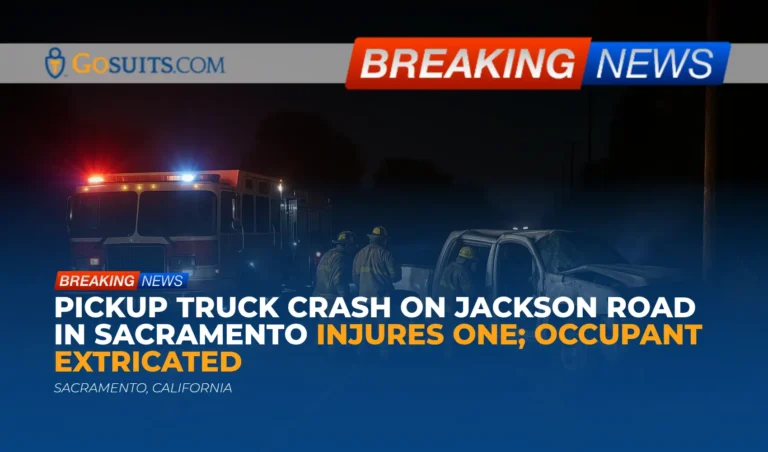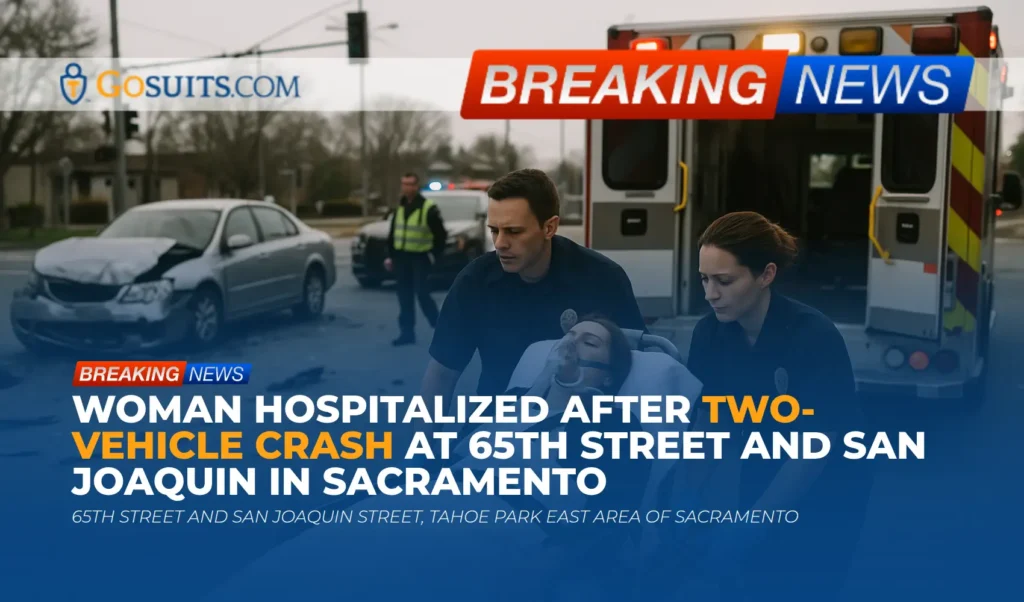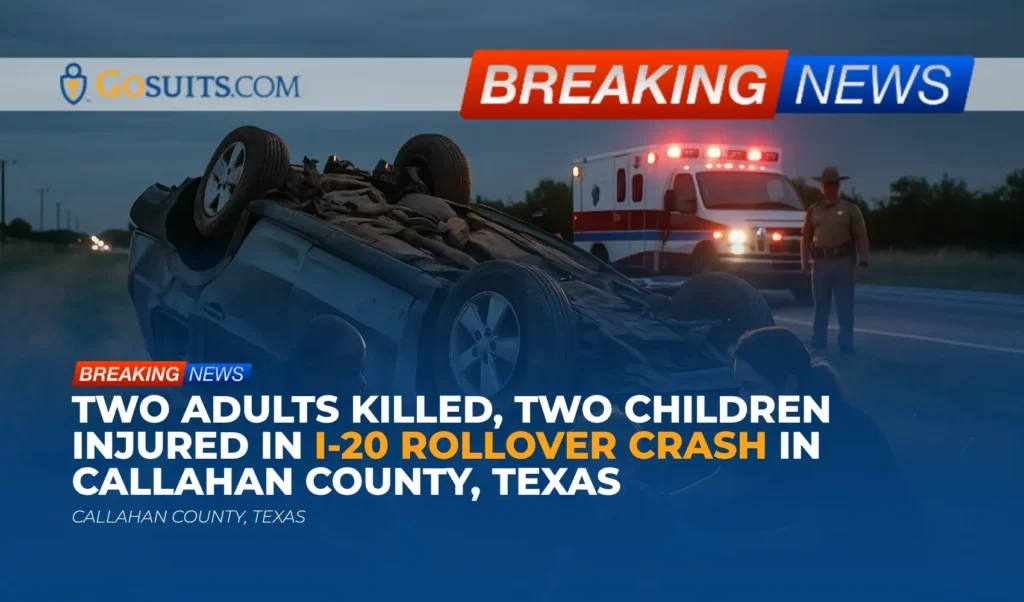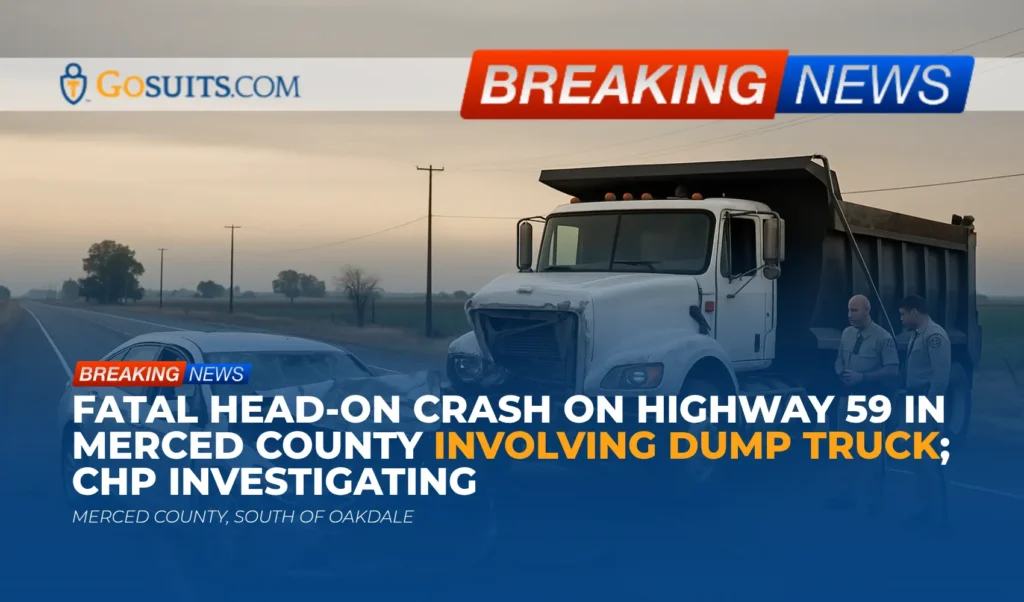- What we know about the Jackson Road crash in Sacramento
- Location, time, and emergency response
- Known injuries and immediate medical care
- What investigators typically examine after a single-vehicle pickup crash
- How California law approaches fault and compensation in traffic collisions
- Steps to document and protect a potential injury claim
- Getting official records: police report, fire incident report, medical records, and—if applicable—coroner records
- Insurance considerations that often arise in pickup-truck crashes
- Safety reflections for night driving on arterial roads
- Data and context: injury risks and nighttime driving
- Resources and points of contact
- Commentary from Gosuits Sacramento, California Personal Injury Attorney
- Why timely action matters now
What we know about the Jackson Road crash in Sacramento
According to information shared by the Sacramento Metropolitan Fire District, a pickup truck crashed on Sunday night in Sacramento, injuring one person. The collision happened at approximately 9:45 p.m. on October 5, 2025, near 10221 Jackson Road. Firefighters reported a male occupant was trapped and required extrication. He was transported to a local hospital for treatment. The cause of the crash remains under investigation, and no additional official details about contributing factors were publicly available at the time of this writing. For agency updates, the Fire District maintains incident information on its official website at metrofire.ca.gov.
Location, time, and emergency response
The incident occurred in Sacramento on Jackson Road, with the specific location described as 10221 Jackson Road. The time of the crash—about 9:45 p.m.—means darkness, reduced visibility, and changing traffic conditions were likely present at the scene. Nighttime conditions can affect reaction time, depth perception, and hazard recognition for drivers in the area.
First responders from the Sacramento Metropolitan Fire District arrived, extricated one trapped occupant, and coordinated transport to a nearby hospital. As of the latest public information, the investigating law enforcement agency has not been specified. In Sacramento County, collisions occurring on certain roadways are commonly investigated by the California Highway Patrol (CHP) or local law enforcement, depending on jurisdiction. Without a formal law enforcement release, it is appropriate to rely on agency reports when they become available rather than speculate.
Known injuries and immediate medical care
The Fire District reported one individual sustained injuries and was taken to a local hospital, though the nature and severity of those injuries were not specified. Extrication suggests the occupant experienced a significant impact or entrapment, and prompt medical assessment is critical following any crash with potential blunt trauma. Even when symptoms seem mild initially, certain injuries—such as internal injuries, concussions, or soft-tissue damage—can worsen over time.
Under federal law, patients generally have a right to obtain their medical records, which can be vital for documenting treatment and understanding next steps. The U.S. Department of Health and Human Services explains patient rights to access medical records here: hhs.gov/hipaa/for-individuals/right-to-access.
What investigators typically examine after a single-vehicle pickup crash
When a pickup-truck crash results in injuries and extrication, investigators usually consider a range of factors to determine what happened. While the cause here has not been released, the following are common areas of inquiry in similar investigations:
- Roadway conditions and lighting: Investigators assess whether the location had adequate lighting, signage, pavement markings, or guardrails, and whether weather or debris played a role. Rural or semi-rural arterials and higher-speed roads can present added risks at night. The Federal Highway Administration has published guidance on reducing roadway-departure crashes on rural roads, including treatments that may mitigate severity when vehicles leave the lane of travel. See FHWA’s overview at highways.dot.gov/safety/proven-safety-countermeasures/rural-road-departures.
- Vehicle dynamics and mechanical condition: Tire condition, steering components, brakes, lighting, and potential defects may be evaluated. The manner of collision and vehicle deformation can help reconstructors understand speed, angle of impact, or a roadway departure.
- Driver factors: Visibility, fatigue, distraction, or impairment are often reviewed. Official findings depend on evidence such as interviews, on-scene observations, and test results when applicable.
- Occupant protection: Whether seatbelts were used, airbag deployment, and how the occupant was seated can influence injury patterns. The Centers for Disease Control and Prevention notes that seat belts substantially reduce the risk of serious injury and death. See cdc.gov/transportationsafety/seatbelts.
- Environmental context: Nighttime glare, wildlife, construction zones, and traffic flow can all factor into a collision sequence.
Official conclusions typically appear in a traffic collision report prepared by the investigating agency and, when needed, supplemented by specialized reconstruction.
How California law approaches fault and compensation in traffic collisions
California civil law provides a general duty for people to act with ordinary care to avoid causing harm to others. This principle is captured in California Civil Code section 1714, which states that everyone is responsible for injuries caused by their lack of ordinary care, except where the law provides otherwise. You can review the statute at leginfo.legislature.ca.gov.
California follows a “pure comparative negligence” system, meaning an injured person’s recovery can be reduced by their percentage of responsibility, if any, but is not barred unless they are 100 percent at fault. The California Supreme Court articulated this framework in Li v. Yellow Cab Co. of California, which you can read through the Stanford Law School archive at scocal.stanford.edu.
Some timelines and special rules often matter:
- Statute of limitations: Most California personal injury claims must be filed within two years of the injury. See Code of Civil Procedure section 335.1 at leginfo.legislature.ca.gov. Certain exceptions can lengthen or shorten this period, depending on circumstances.
- Claims involving public entities: If a claim is asserted against a public entity (for example, alleging a dangerous condition of public property), California’s Government Claims Act generally requires a written claim to be presented within six months of the incident. See Government Code section 911.2 at leginfo.legislature.ca.gov.
- Uninsured vehicle limitations: If the injured person was driving their own uninsured vehicle, Civil Code section 3333.4 can limit recovery of non-economic damages in certain cases. See the statute at leginfo.legislature.ca.gov.
Each crash is fact-specific. The presence or absence of another involved vehicle, the role of roadway conditions, the extent of injuries, and insurance coverage all influence how a claim proceeds.
Steps to document and protect a potential injury claim
These practical measures can help preserve information and protect a person’s rights after a serious collision. Because what someone says to an insurer can be used later, it is prudent to speak with an attorney in a free consultation before giving any recorded statement or signing any forms.
- Get timely medical care and follow-up: Keep all appointments and follow medical guidance. Save discharge papers, prescriptions, referrals, and receipts.
- Preserve evidence: Store damaged items, keep the vehicle unaltered when possible until it is documented, and take photographs of the scene conditions, vehicle damage, and visible injuries.
- Collect information: Secure the name of the investigating agency, incident number if provided, tow yard information, and names of witnesses.
- Make a personal record: Note pain levels, limitations, missed work, and daily impacts. This can help document non-economic harms and the progression of recovery.
- Be cautious with insurers: Insurance adjusters may request recorded statements quickly. Consider consulting an attorney first; statements can be cited against you later. California’s Department of Insurance provides consumer information on auto insurance claims processes at insurance.ca.gov.
- Know mandatory reporting thresholds: California requires drivers to submit a DMV SR-1 report within 10 days if anyone was injured or if property damage exceeds a threshold set by the state. The DMV explains accident reporting requirements here: dmv.ca.gov/vehicle-registration/insurance/accident-reporting-requirements. The SR-1 form is available at dmv.ca.gov/dmv-forms/sr/sr1.
Getting official records: police report, fire incident report, medical records, and—if applicable—coroner records
Official records clarify what happened, who responded, and what was documented. Here is how people typically obtain key records in Sacramento County and statewide.
Traffic collision report (law enforcement)
If the California Highway Patrol (CHP) investigated, a copy of the traffic collision report can be requested. The CHP provides a “Request for Collision Report” process and form CHP 190. See the CHP’s page on requesting a collision report at chp.ca.gov/notify-chp/request-a-collision-report and the CHP 190 form at chp.ca.gov/CHP-Forms/CHP-190. Reports are generally available to involved parties, their legal representatives, and insurers. If a different agency investigated, request instructions are typically posted on that agency’s official website.

Fire and rescue incident records
The Sacramento Metropolitan Fire District maintains records and may provide incident reports upon request, subject to privacy laws. Visit the Fire District’s official website at metrofire.ca.gov to locate its records request or public information page. When requesting, having the date, approximate time, location (10221 Jackson Road), and nature of the incident can help staff locate the correct record.
Medical records
Hospitals and clinics maintain medical charts, imaging, and billing records. Patients and authorized representatives have a right to request copies. The U.S. Department of Health and Human Services outlines patient access rights here: hhs.gov/hipaa/for-individuals/right-to-access. Bringing a government-issued ID and completing the provider’s release form will usually be required.
If a fatality occurs: coroner records and next-of-kin support
This Jackson Road crash was reported as an injury incident. If a traffic collision involves a death, the county coroner handles the investigation, next-of-kin notifications, and release of remains. In Sacramento County, the Coroner’s Office information and procedures can be found through the county’s official website at saccounty.gov. Inquiries typically require identifying information such as the decedent’s name and date of death.
Families may also need the official death certificate and, when relevant, the coroner’s report or autopsy report. Each carries specific request procedures and timelines. If a public records request is necessary, California’s Public Records Act provides a framework for accessing non-exempt public records. The California Attorney General provides a summary of the Act at oag.ca.gov.
Insurance considerations that often arise in pickup-truck crashes
Insurance coverage and claim sequencing can be pivotal after a serious crash. Because statements can shape outcomes, it is wise to consult with an attorney before speaking with any insurer about fault or injuries.
- Liability coverage: If another party contributed to the crash (for example, by creating a roadway hazard or through negligent maintenance of a vehicle), that party’s liability insurance may apply. Establishing negligence requires evidence such as the traffic report, photos, and witness statements.
- Uninsured/underinsured motorist (UM/UIM): If another driver was involved and lacked adequate coverage, UM/UIM provisions on a policy can help. The California Department of Insurance offers consumer guides about auto coverages at insurance.ca.gov.
- MedPay and health insurance: Medical payments coverage can offset out-of-pocket costs regardless of fault, up to policy limits. Health insurance often becomes primary after MedPay is exhausted.
- Property damage and total loss: Pickup frames and suspensions can sustain significant damage in roadway departures or impacts with fixed objects. Independent appraisals and thorough photo documentation can be useful in valuation discussions.
- Comparative fault and statements: California’s pure comparative negligence system means even partial fault allocations can reduce compensation. Recorded statements given early can be used by insurers to argue for higher fault percentages. It is often prudent to get a free consultation before any recorded interview.
- Special issues for uninsured vehicle owners: Under Civil Code section 3333.4, people driving their own uninsured vehicles may face limits on non-economic damages. Review the statute at leginfo.legislature.ca.gov and consider discussing circumstances with counsel.
Safety reflections for night driving on arterial roads
Although the precise cause of this crash is not yet known, nighttime conditions on arterial roadways and rural connectors can elevate risk. The combination of speed, limited lighting, and unexpected hazards often leaves less margin for error. The Federal Highway Administration’s emphasis on mitigating roadway departures reflects how leaving the lane—even momentarily—can lead to severe outcomes, especially in higher-profile vehicles like pickups. See FHWA’s resources on rural roadway departures: highways.dot.gov/safety/proven-safety-countermeasures/rural-road-departures.
Seat belts remain one of the most important protections in any crash. The CDC notes that seat belt use significantly reduces the risk of fatal and serious injuries for drivers and passengers. For more on seat belt effectiveness and usage, see cdc.gov/transportationsafety/seatbelts.
If the road where a crash occurred is state-maintained, concerns about debris, potholes, or other hazards can be submitted to Caltrans for review through its maintenance program. Caltrans provides service request information at dot.ca.gov/programs/maintenance.
Data and context: injury risks and nighttime driving
Public safety data helps place single-vehicle injury crashes in context even when specific causation has not been determined. Several consistent patterns emerge in national and statewide data:
- Nighttime risk: A disproportionate share of severe road departures and fixed-object crashes occur at night, when visibility decreases and fatigue may be a factor.
- Seat belt effectiveness: Seat belts remain one of the most effective injury-prevention measures for occupants. The CDC emphasizes that they substantially reduce the risk of fatal injury, and reinforces the importance of consistent use across all seating positions. See cdc.gov/transportationsafety/seatbelts.
- Rural roadway departure emphasis: FHWA promotes proven countermeasures to reduce roadway departures, such as shoulder widening, rumble strips, and clear zones. See FHWA’s overview at highways.dot.gov/safety/proven-safety-countermeasures/rural-road-departures.
- California collision patterns: State and county-level collision data and rankings are regularly compiled by the California Office of Traffic Safety, which can provide insights into local trends and risks. See OTS resources at ots.ca.gov/media-and-research/crash-rankings.
Every crash is unique, but awareness of common patterns can guide prevention efforts and inform what evidence may matter in an investigation.
Resources and points of contact
The following official resources may help those navigating the aftermath of a Sacramento-area collision like the Jackson Road crash:
- Sacramento Metropolitan Fire District (incident information and records): metrofire.ca.gov
- California Highway Patrol (collision reports): chp.ca.gov/notify-chp/request-a-collision-report and CHP 190 form
- California DMV (accident reporting and SR-1 form): dmv.ca.gov/vehicle-registration/insurance/accident-reporting-requirements and dmv.ca.gov/dmv-forms/sr/sr1
- California Department of Insurance (consumer guidance on auto claims): insurance.ca.gov
- Sacramento County (Coroner’s Office and county services): saccounty.gov
- Caltrans Maintenance Service Requests (report a roadway condition on state-maintained roads): dot.ca.gov/programs/maintenance
- California Public Records Act overview (Attorney General): oag.ca.gov

Commentary from Gosuits Sacramento, California Personal Injury Attorney
Our hearts go out to the person injured on Jackson Road and to everyone affected. This article is meant to share general information and education about what typically follows a collision, not to provide legal advice for any specific case. When someone is trapped and needs extrication, the impact on the person and their family can be profound—physically, emotionally, and financially.
From a civil-injury standpoint, the unanswered question is why this crash occurred. Thorough investigations look at the roadway environment, lighting, vehicle condition, and any external contributors, not just driver behavior. If another party’s negligence played a role—such as an unaddressed roadway hazard or a defective component—that can shift or share responsibility. California’s pure comparative negligence system, recognized in the Li v. Yellow Cab decision, allows a careful allocation of fault so injured people are not barred from pursuing recovery even if multiple factors are involved.
It is unfortunately common for insurers and large businesses to move quickly after an incident to shape the narrative. Early recorded statements, selective requests for “authorization” forms, and quick, low settlement offers can all reduce the value of a claim before the full medical picture is known. Adjusters may appear helpful while asking questions designed to limit payouts. Preserving evidence, obtaining the collision report and medical documentation, and having a confidential conversation with a seasoned and skilled injury attorney before giving statements can help level the playing field.
Free consultations are a safe way to understand rights and options early. They allow people to ask questions about timelines, insurance coverages, reimbursement pathways, and what evidence will matter without committing to any course of action. Learning the difference between a routine property damage claim and a bodily injury claim, and how California deadlines work—especially if a public entity might be involved—can prevent missed opportunities later.
Why timely action matters now
Taking the right steps promptly can make a meaningful difference in outcomes after a serious collision. Here is what should be done and why timing is critical:
- Secure and preserve evidence immediately: Physical evidence can be lost when vehicles are moved, repaired, or salvaged. Early photographs, vehicle inspections, and preservation letters help protect key information about damage patterns, restraint use, and potential mechanical issues.
- Obtain official records as soon as they are available: Traffic collision reports, fire incident summaries, and medical records provide the backbone for insurance evaluations. Some records take time to release; initiating requests early helps keep a case moving and prevents gaps in documentation.
- Protect the timeline: California has deadlines that can arrive sooner than expected. Most personal injury claims carry a two-year filing limit, and some claims against public entities require formal notice within six months. Acting promptly ensures there is time to investigate and, if needed, consult technical experts.
- Avoid premature statements that can be used later: Early calls with insurers often include recorded questions that may affect fault allocation. Waiting to understand rights and the full medical picture before giving statements helps prevent misunderstandings and protects the integrity of the claim.
- Document medical care and recovery from day one: Thorough, consistent medical documentation supports a clear link between the crash and the injuries. Saving bills, mileage logs for appointments, and notes about daily limitations helps ensure that both economic and non-economic impacts are recognized.
- Clarify all available insurance coverages: Identifying liability, UM/UIM, MedPay, and health coverage early avoids delays in care and reimbursement. Understanding the coordination between policies can reduce out-of-pocket strain and prevent missed benefits.
- Assess potential roadway or third-party factors: When a crash might involve a dangerous condition of public property or a third-party contractor’s work, those avenues must be evaluated quickly due to shorter deadlines and the need to capture condition evidence before it changes.
Early, informed action reduces uncertainty and helps ensure important rights are not lost to deadlines or missing documentation.






